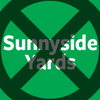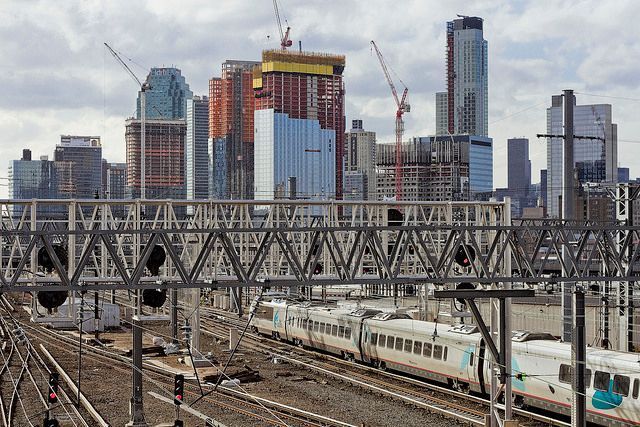Trivia Night: Sunnyside Yards Edition Questions.
Test your knowledge of the Sunnyside Yards mega-development project based on the city-funded feasibility study and appendix. Then tell your friends...
- Which statement is MOST ACCURATE? The Sunnyside Yards Feasibility Study:
a. Identifies key considerations, planning principles and provides a development framework for a future overbuild;
b. Was commissioned as a stand-alone document to illustrate the feasibility of such a project and, therefore, key considerations within are not applicable;
c. Should be followed by more extensive investigations of railroad, engineering and urban issues to further understand its feasibility;
d. Both A and C.
- Due to high volumes of traffic along the Main Line, construction of the platform in the rail yards will occur:
a. 9 a.m. to 5 p.m., Monday through Friday;
b. 10 a.m. to 3 p.m., Monday-Friday and every other Saturday 7a.m.-7p.m to avoid rush hour train traffic;
c. Mostly overnights or 55-hour weekend shifts;
d. A or B, depending on the time of year
- Covering the rail yard with a platform will:
a. Make the rail yard slightly warmer for workers underneath, but any hot air will dissipate quickly on its own;
b. Not be noticeable to the average worker underneath, but may be a problem for those sensitive to heat;
c. May require ventilation with jet fans, the noise of which will likely be heard by neighbors above the platform and may require noise dampeners;
d. None of the above
- NYS Dept. of Environmental Conservation lists SY as a Class 2 Superfund Site. A Class 2 site is a site where:
a. Hazardous waste presents a significant threat to the public health or the environment and action is required;
b. Contaminants such as lead, PCBs or other carcinogenic materials can be found;
c. Action is required only if Amtrak has the superfunds to do so;
d. Both A and B
- Remedial actions, such as clean-up of the Sunnyside Yards, as required by NYS Department of Environmental Conservancy:
a. Is complete in some areas, but ongoing in others;
b. Was cleaned up only to levels appropriate for industrial uses of the land such as a railway;
c. Limits the use and development of the property to industrial use despite previous excavation and off-site disposal of contaminated soil;
d. All of the above
- Before a platform overbuild can proceed, the following should occur:
a. Additional soil & groundwater testing should be done to determine whether corrosive elements are present where the foundation shafts are to be installed;
b. Due to the complexity of the geological layering within SY, comprehensive subsurface investigations will need to be done before foundation design;
c. Fire is a significant risk presented by enclosing Sunnyside Yards and could release heat that impacts the deck structure and, therefore, fire protection systems should meet the requirements of FDNY, and other building codes;
d. All of the above
- Appendix D of the Feasibility Study states that threat analysis, including derailment of trains and their impact, has been incorporated into the design. True or False?
- It is anticipated that most materials would be delivered by truck to areas surrounding and within Sunnyside Yards as delivery by rail is unlikely to be cost competitive. True or False?
- Rent for an 800 sq. ft. 1- bedroom in 10 years will cost, based on estimate from 2017, at inflation rate of 3%:
a. $5,500
b. $4,000
c. $2,900
d. $3,500
- A Sunnyside Yards overbuild will seamlessly enclose and cover 100% of the train yard, similar to Hudson Yards. True of False?
- The sewer systems surrounding SY are just adequate enough to support the increase in demand by the overbuild development and, therefore, no new sewers would need to be built. True or False?
- Due to heavy investments in the late 1990’s the water distribution piping does not need to be modernized. True of False?
- The overbuild will require Con Ed to build SEVEN additional distribution substations that:
a. Will need to be housed on approximately ½ acre each, and will not be able to be placed underground like local substations;
b. Will be funded through Con Ed’s user rate structure;
c. Includes several microtunnel installations, the route feasibility of which have not been tested
d. All of the above
- The estimated cost to build additional utility networks to supply electricity to the area as listed in the “Estimated Cost of Off-site Utility Improvements” in section H of the Feasibility Study Appendix is:
a. $97 Million
b. $50 Million
c. $223 Million
d. Not estimated
- Building a large park, or mostly-wild parkland similar to Central Park in order to combat climate change over Sunnyside Yards is:
a. Something planners are considering, based on drawings in the feasibility study’s appendix;
b. Is specifically mentioned in the feasibility study as a serious option considering the popularity of the Green New Deal and the passage of New York City’s Climate Mobilization Act;
c. Both A and B.
d. None of the above.
- The Public Open Spaces Network on the Sunnyside Yards overbuild:
a. Represents approximately 17.5% of the 180-acre project site;
b. Represents .97 acres per 1000 people which is below the City’s recommended 1.25-acres per 1,000 residents;
c. Includes formal building entry plazas, and a planted median along a new boulevard;
d. All of the above.
- Location and design of the major open spaces will mainly be limited to where the development of towers is not feasible. True or False?
- Affordable housing will be prioritized over market rate units to ease the homeless crisis in the city, and to be consistent with Mayor de Blasio’s housing initiative. True or False?
- Commitments by the EDC, DCP, developers and other state & city agencies as to affordability levels, cost, park design, infrastructure needs, etc. will be decided upfront in conjunction with the de Blasio administration and the community, and, therefore, must be adhered to until the project is complete. True or False?
- An additional subway LINE to alleviate overcrowding in Sunnyside, Astoria & LIC is being discussed. True or False?
- The existing subway lines are considered adequate to support the overbuild and current residents. True or False?
- The cost of an overbuild on Sunnyside Yards:
a. Is relatively reasonable due to advances in construction materials and machinery;
b. Is relatively reasonable despite strong labor contracts;
c. Will incur a range of extraordinary costs associated with materials, labor, and equipment;
d. Both A and B
- The cost of an overbuild on Sunnyside Yards:
a. Will be absorbed relatively quickly due to higher economic levels of newly arriving residents;
b. Will include large up-front expenditures that may not see returns for many decades;
c. Will include large back-end expenditures that will have been paid for beforehand by higher income residents;
d. Both A and B
- The tallest residential building, including a 6-story podium, could be:
a. 70 stories
b. 55 stories
c. 18 stories
d. 35 stories
- Deck height on the overbuild is a maximum of 30 feet, or approximately 3 stories. True or False?
- Deck height is such that:
a. Creating an accessible link between the deck and the adjacent streets presents a design challenge;
b. Vehicular access to Sunnyside Yards in some areas is infeasible due to steep grades;
c. Switchbacks, stairs, or elevators will be required to make pedestrian connections;
d. All of the above
- If residential units contain an average of 2.5 people per unit, what is the minimum number of new residents on Sunnyside Yards? Must come closest without going over.
- If residential units contain an average of 2.5 people per unit, what is the maximum number of new residents on Sunnyside Yards? Must come closest without going over.
- Large–scale buildings and higher densities will be required to maximize the development potential and the economic viability of the project. True or False?
- A 10-car Private Car Track, and adjacent access road, is being constructed for individuals, groups, or companies who will own their own rail cars, which will be coupled with regularly scheduled Amtrak service. True or False?
THE FOLLOWING ARE BONUS ??? NOT BASED ON FEASIBILITY STUDY
- Which former or current NYC official is quoted as saying that Central Park should never have been built?
a. Dan Doctoroff
b. Alicia Glen
c. Bill de Blasio
d. Vishaan Chakrabarti
- Who is the architect/master planner hired to develop Sunnyside Yard’s Master Plan?
a. Dan Doctoroff
b. Alicia Glen
c. Bill de Blasio
d. Vishaan Chakrabarti
- Which former or current NYC official is working on Sunnyside Yard’s Master Plan and also worked to develop Hudson Yards, which has been deemed the most expensive private development in U.S. history.
a. Dan Doctoroff
b. Alicia Glen
c. Bill de Blasio
d. Vishaan Chakrabarti
- How much did the architect/master planner get paid to create the Sunnyside Yards master plan? Must come closest without going over.
ANSWER KEY.......
- D
- C
- C
- D
- D
- D
- False
- True
- A
- False - Approximately 20% of the total space will be left uncovered due to the difficulty of building over an area with very heavy train traffic. The area to be left open is above the Main Line which runs parallel to Skillman Avenue.
- False – NYC Dept. Of Environmental Protection’s wastewater treatment plants cannot accept any new/increased stormwater flows. Therefore, a new separate storm-only sewer would have to be built along Skillman Avenue and outfall into the Dutch Kill.
- False - Upgrade of distribution supply network piping is required to meet increased demand and redundancy in case of pipe breaks.
- D
- D
- D
- D. Note that in 9/2019, EDC stated that additional open space would be allocated to SY, but that claim has not been verified by a neutral 3rd party.
- True
- False - Market-rate units are estimated to be completed at 520 units per year, while affordable units will have to rely on the availability of financing and construction timing.
- False - Policy changes such as requiring additional affordable housing or additional non-revenue producing community uses (i.e., open space); modifications to tax policy; or changes in construction costs are risks that could reduce the feasibility of this plan.
- False.
- False - Existing transit networks lack capacity to handle the additional development of a full buildout. Investments would need to be made to improve capacity at existing subway lines and stations.
- C
- B
- A
- False - the deck height in the feasibility study is shown to be up to 109 feet high or over 10 stories tall. Note that in 9/2019, EDC stated that a lower height had been negotiated, but that claim has not been verified by a neutral 3rd party.
- D
- 27,500 [11,000 units]
- 60,000 [24,000 units]
- True
- True
- D
- D
- D
- $9 Million

